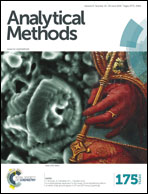Rapid and direct detection of illicit dyes on tainted fruit peel using a PVA hydrogel surface enhanced Raman scattering substrate†
Abstract
Food safety is one of the major concerns for consumers all around the world. Here in this work, we present a method that can be used for direct onsite fast screening of illicit additives on fruit peel. The method is based on our newly developed poly(vinyl alcohol) (PVA) hydrogel (slime) SERS substrate, which can conform to any surface shape. Simply by applying the hydrogel SERS substrate on the surface of interest, the limit of quantification for Sudan red (SR) III on a glass surface was found to be 1.6 ng/4 cm2. The time decay of SR III on a spiked kumquat was monitored with the proposed hydrogel SERS method and verified by HPLC. It was found that even after 25 days since dying, SR III could still be clearly identified at a level of dozens of ppb. With virtually no sample preparation requirement, the whole analysis procedure only took less than 5 min. Thus, the hydrogel SERS substrate based method could be used for future onsite food quality assurance applications when combined with a portable Raman spectrometer.


 Please wait while we load your content...
Please wait while we load your content...